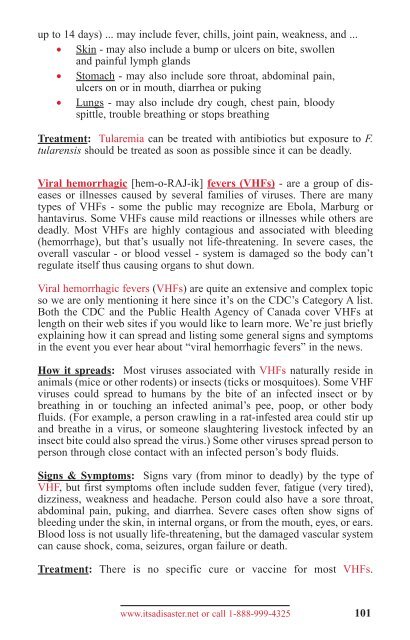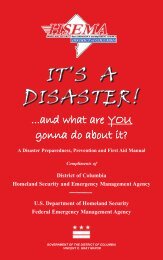disaster 5th 1108_5th ed 2011 - Homeland Security and Emergency ...
disaster 5th 1108_5th ed 2011 - Homeland Security and Emergency ...
disaster 5th 1108_5th ed 2011 - Homeland Security and Emergency ...
You also want an ePaper? Increase the reach of your titles
YUMPU automatically turns print PDFs into web optimized ePapers that Google loves.
up to 14 days) ... may include fever, chills, joint pain, weakness, <strong>and</strong> ...<br />
• Skin - may also include a bump or ulcers on bite, swollen<br />
<strong>and</strong> painful lymph gl<strong>and</strong>s<br />
• Stomach - may also include sore throat, abdominal pain,<br />
ulcers on or in mouth, diarrhea or puking<br />
• Lungs - may also include dry cough, chest pain, bloody<br />
spittle, trouble breathing or stops breathing<br />
Treatment: Tularemia can be treat<strong>ed</strong> with antibiotics but exposure to F.<br />
tularensis should be treat<strong>ed</strong> as soon as possible since it can be deadly.<br />
Viral hemorrhagic [hem-o-RAJ-ik] fevers (VHFs) - are a group of diseases<br />
or illnesses caus<strong>ed</strong> by several families of viruses. There are many<br />
types of VHFs - some the public may recognize are Ebola, Marburg or<br />
hantavirus. Some VHFs cause mild reactions or illnesses while others are<br />
deadly. Most VHFs are highly contagious <strong>and</strong> associat<strong>ed</strong> with ble<strong>ed</strong>ing<br />
(hemorrhage), but that’s usually not life-threatening. In severe cases, the<br />
overall vascular - or blood vessel - system is damag<strong>ed</strong> so the body can’t<br />
regulate itself thus causing organs to shut down.<br />
Viral hemorrhagic fevers (VHFs) are quite an extensive <strong>and</strong> complex topic<br />
so we are only mentioning it here since it’s on the CDC’s Category A list.<br />
Both the CDC <strong>and</strong> the Public Health Agency of Canada cover VHFs at<br />
length on their web sites if you would like to learn more. We’re just briefly<br />
explaining how it can spread <strong>and</strong> listing some general signs <strong>and</strong> symptoms<br />
in the event you ever hear about “viral hemorrhagic fevers” in the news.<br />
How it spreads: Most viruses associat<strong>ed</strong> with VHFs naturally reside in<br />
animals (mice or other rodents) or insects (ticks or mosquitoes). Some VHF<br />
viruses could spread to humans by the bite of an infect<strong>ed</strong> insect or by<br />
breathing in or touching an infect<strong>ed</strong> animal’s pee, poop, or other body<br />
fluids. (For example, a person crawling in a rat-infest<strong>ed</strong> area could stir up<br />
<strong>and</strong> breathe in a virus, or someone slaughtering livestock infect<strong>ed</strong> by an<br />
insect bite could also spread the virus.) Some other viruses spread person to<br />
person through close contact with an infect<strong>ed</strong> person’s body fluids.<br />
Signs & Symptoms: Signs vary (from minor to deadly) by the type of<br />
VHF, but first symptoms often include sudden fever, fatigue (very tir<strong>ed</strong>),<br />
dizziness, weakness <strong>and</strong> headache. Person could also have a sore throat,<br />
abdominal pain, puking, <strong>and</strong> diarrhea. Severe cases often show signs of<br />
ble<strong>ed</strong>ing under the skin, in internal organs, or from the mouth, eyes, or ears.<br />
Blood loss is not usually life-threatening, but the damag<strong>ed</strong> vascular system<br />
can cause shock, coma, seizures, organ failure or death.<br />
Treatment: There is no specific cure or vaccine for most VHFs.<br />
www.itsa<strong>disaster</strong>.net or call 1-888-999-4325<br />
101





